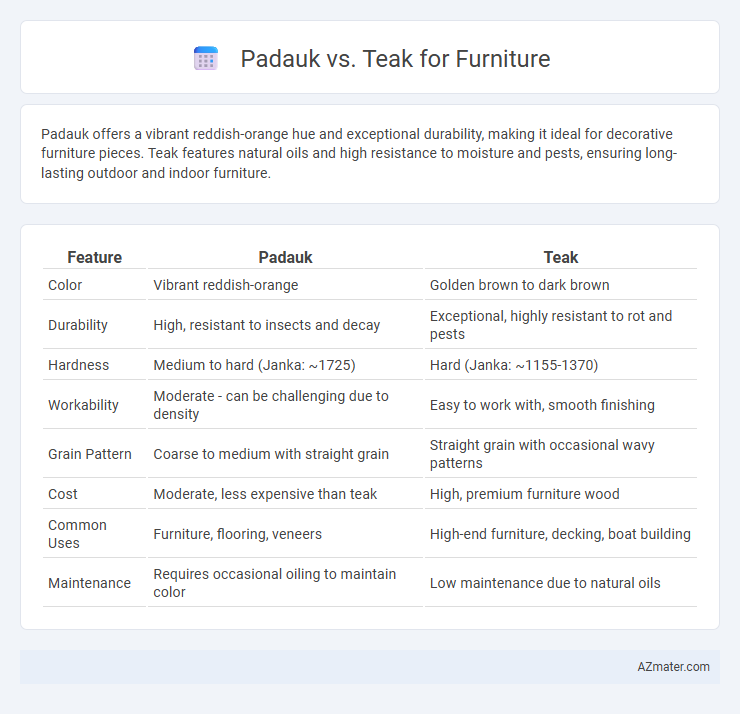Padauk offers a vibrant reddish-orange hue and exceptional durability, making it ideal for decorative furniture pieces. Teak features natural oils and high resistance to moisture and pests, ensuring long-lasting outdoor and indoor furniture.
Table of Comparison
| Feature | Padauk | Teak |
|---|---|---|
| Color | Vibrant reddish-orange | Golden brown to dark brown |
| Durability | High, resistant to insects and decay | Exceptional, highly resistant to rot and pests |
| Hardness | Medium to hard (Janka: ~1725) | Hard (Janka: ~1155-1370) |
| Workability | Moderate - can be challenging due to density | Easy to work with, smooth finishing |
| Grain Pattern | Coarse to medium with straight grain | Straight grain with occasional wavy patterns |
| Cost | Moderate, less expensive than teak | High, premium furniture wood |
| Common Uses | Furniture, flooring, veneers | High-end furniture, decking, boat building |
| Maintenance | Requires occasional oiling to maintain color | Low maintenance due to natural oils |
Introduction to Padauk and Teak Wood
Padauk wood is prized for its vibrant reddish-orange hue that deepens over time, offering a striking aesthetic for furniture. Teak wood, known for its exceptional durability and natural oils, provides superior resistance to moisture and pests, making it ideal for both indoor and outdoor furniture. Both woods are hardwoods renowned for their strength, but Padauk's bold color contrasts with Teak's warm golden brown tones, influencing furniture style and application choices.
Origins and Botanical Background
Padauk, a tropical hardwood primarily sourced from Africa and Southeast Asia, belongs to the Pterocarpus genus, known for its striking reddish-orange hues and durability. Teak, native to South and Southeast Asia, is from the Tectona genus, prized for its natural oils, resistance to decay, and golden-brown color. Both woods are botanically classified as hardwoods but differ significantly in their growth environments and cellular structures, influencing their use in premium furniture making.
Visual Appearance: Color and Grain Patterns
Padauk furniture stands out with its vibrant reddish-orange hue that gradually deepens to a rich purple-brown over time, offering a striking visual appeal. Teak wood features a warm golden-brown color that ages gracefully to a silvery-gray patina, prized for its natural luster and oily texture. Both woods showcase distinctive grain patterns: Padauk displays straight to interlocked grains with a coarse texture, while Teak exhibits a straight to wavy grain with a smooth and even surface, making each ideal for unique furniture aesthetics.
Durability and Resistance to Elements
Padauk offers excellent durability with a Janka hardness rating of approximately 1,510, making it highly resistant to wear and impact, while teak ranks slightly higher around 1,070 but is renowned for its exceptional resistance to moisture, decay, and insects due to its natural oils. Teak's natural oils provide superior resistance to outdoor elements, ensuring furniture longevity even in harsh weather conditions, whereas padauk, though durable, may require regular sealing to maintain its resilience against moisture and UV rays. Both woods are suitable for high-quality furniture, but teak's inherent weather-resistant properties make it the preferred choice for outdoor applications demanding maximum durability and resistance.
Workability and Ease of Crafting
Padauk wood, known for its vibrant reddish-orange hue, offers excellent workability with sharp tools, making it a favorite for intricate furniture designs and fine detailing. Teak, prized for its natural oils and dense grain, presents moderate workability but is highly durable and resistant to wear, which may require more effort in crafting and finishing. Both woods provide quality durability, yet Padauk's smoother cutting experience often results in less sanding and easier shaping compared to Teak's tougher texture.
Cost Comparison: Padauk vs Teak
Padauk furniture generally costs less than teak due to its faster growth rate and greater availability, making it a more affordable option for high-quality hardwood pieces. Teak commands a premium price because of its exceptional durability, natural oils that resist weathering, and slower growth, which increase harvesting costs. Choosing between Padauk and teak depends on budget considerations and desired longevity, with teak being a higher-cost investment and Padauk offering a balance of durability and affordability.
Maintenance Requirements and Longevity
Padauk offers vibrant reddish-orange hues and requires regular oiling to maintain its color and prevent drying or cracking, making consistent maintenance essential. Teak contains natural oils that provide inherent resistance to moisture, pests, and decay, resulting in lower upkeep demands and exceptional durability over decades. Both woods are highly durable, but teak's self-protective properties generally ensure longer-lasting furniture with less frequent maintenance compared to padauk.
Environmental Impact and Sustainability
Padauk wood, sourced primarily from Africa and Southeast Asia, is considered a more sustainable option due to faster growth rates and better availability compared to teak, which thrives in limited tropical regions and faces overharvesting concerns. Teak's dense oil content provides durability but requires longer maturation periods, intensifying environmental impact through habitat disruption and deforestation. Choosing Padauk supports lower carbon footprints and promotes biodiversity by reducing pressure on endangered teak forests.
Best Uses for Each Wood in Furniture Design
Padauk offers rich reddish-orange hues and durability, making it ideal for decorative furniture pieces like cabinets and accent tables where visual warmth is desired. Teak's natural oils and dense grain provide exceptional resistance to moisture and pests, making it the preferred choice for outdoor furniture and high-traffic indoor pieces. Both woods excel in fine woodworking, but Padauk is favored for striking aesthetics while teak prioritizes longevity and weather resistance.
Final Verdict: Choosing Between Padauk and Teak
Padauk offers vibrant reddish hues and excellent durability, making it ideal for statement furniture pieces with a striking aesthetic. Teak boasts superior natural oils and resistance to moisture, ensuring long-lasting performance and minimal maintenance, especially for outdoor or high-traffic use. Choosing between Padauk and Teak depends on prioritizing bold visual appeal versus unmatched weather resistance and longevity in furniture craftsmanship.

Infographic: Padauk vs Teak for Furniture
 azmater.com
azmater.com